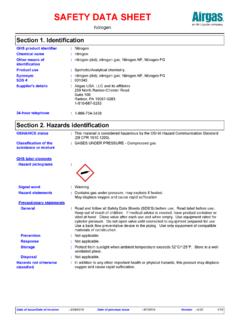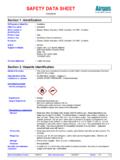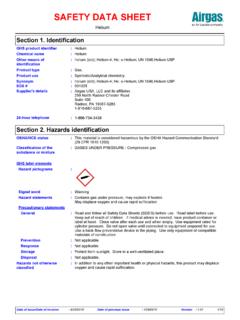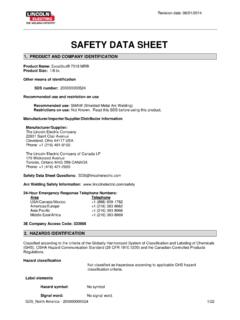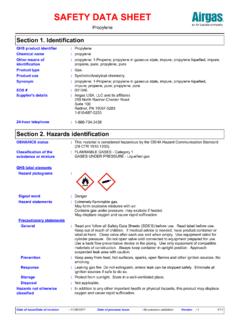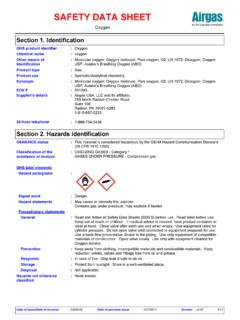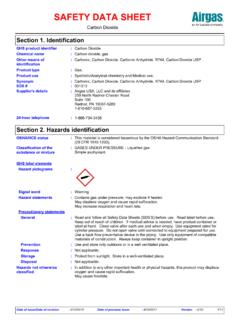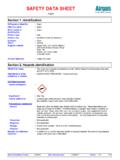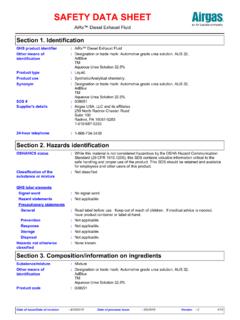Transcription of SAFETY DATA SHEET - Airgas
1 Revision Date: 10/05/2018 SDS_North America - 200000007592 1/18 SAFETY data SHEET 1. PRODUCT AND COMPANY IDENTIFICATION Product Name: Stay Silv White Flux Other means of identification SDS number: 200000007592 Recommended use and restriction on use Recommended use: Metal brazing Restrictions on use: Not known. Read this SDS before using this product. Manufacturer/Importer/Supplier/Distribut or Information Company Name: Radnor Welding Products Address: Box 6675 Radnor, PA 19087 USA Telephone: +1 (866) 924-7427 Emergency telephone number: +1 (866) 734-3438 2. HAZARDS IDENTIFICATION Classified according to the criteria of the Globally Harmonized System of Classification and Labeling of Chemicals (GHS), The United States Occupational SAFETY and Health Administration s Hazard Communication Standard (29 CFR ), Canada s Hazardous Product Regulations and Mexico s Harmonized System for the Identification and Communication of Hazards and Risks from Hazardous Chemicals in the Workplace.
2 Hazard Classification Health HazardsAcute toxicity (Oral) Category 4 Acute toxicity (Dermal) Category 3 Acute toxicity (Inhalation - dust and mist) Category 4 Toxic to reproduction Category 2 Hazard Symbol: Signal Word: Danger Hazard Statement: Toxic in contact with skin. Harmful if swallowed or if inhaled. Suspected of damaging fertility or the unborn child. Precautionary Label Elements Revision Date: 10/05/2018 SDS_North America - 200000007592 2/18 Statements: Prevention: Wear protective gloves/protective clothing/eye protection/face protection. Avoid breathing dust/fume/gas/mist/vapors/spray. Use only outdoors or in a well-ventilated area. Wash thoroughly after handling. Do not eat, drink or smoke when using this product. Obtain special instructions before use. Do not handle until all SAFETY precautions have been read and understood.
3 Use personal protective equipment as required. Response: IF INHALED: Remove person to fresh air and keep comfortable for breathing. IF ON SKIN: Wash with plenty of water/.. IF SWALLOWED: Call a POISON CENTRE/doctor/.. if you feel unwell. Rinse mouth. Call a POISON CENTER/doctor if you feel unwell. Specific measures (see this label). Take off immediately all contaminated clothing. Wash contaminated clothing before reuse. Storage: Store locked up. Disposal: Dispose of contents/container to an appropriate treatment and disposal facility in accordance with applicable laws and regulations, and product characteristics at time of disposal. Other hazards which do not result in GHS classification: Heat rays (infrared radiation) from flame or hot metal can injure eyes. Overexposure to brazing fumes and gases can be hazardous. Read and understand the manufacturer s instructions, SAFETY data Sheets and the precautionary labels before using this product.
4 Substance(s) formed under the conditions of use: Fumes produced from use of this product may contain the following constituent(s) and/or their complex metallic oxides as well as solid particles or other constituents from the solder, brazing consumable, flux material or base metal, or base metal coating not listed below. Hydrogen fluoride, a possible decomposition product, is extremely corrosive and a poison by all routes of entry. Hydrogen fluoride can penetrate the skin and produce burns, which may not be immediately painful or visible; the burns impact the lower layers of skin and bone tissue. Hydrogen fluoride exposures involving 20 percent of the body or more can be fatal through systemic fluoride poisoning. Chemical Identity CAS-No. Carbon dioxide 124-38-9 Carbon monoxide 630-08-0 Nitrogen dioxide 10102-44-0 Ozone 10028-15-6 3.
5 COMPOSITION / INFORMATION ON INGREDIENTS Reportable Hazardous Ingredients Mixtures Chemical Identity CAS number Content in percent (%)* Potassium difluorodihydroxyborate(1-) 85392-66-1 50 - <100% Potassium fluoride 7789-23-3 25 - <50% * All concentrations are percent by weight unless ingredient is a gas. Gas concentrations are in percent by volume. Revision Date: 10/05/2018 SDS_North America - 200000007592 3/18 Composition Comments: The term Hazardous Ingredients should be interpreted as a term defined in Hazard Communication standards and does not necessarily imply the existence of a welding hazard. The product may contain additional non-hazardous ingredients or may form additional compounds under the condition of use. Refer to Sections 2 and 8 for more information. 4. FIRST AID MEASURES Ingestion: Avoid hand, clothing, food, and drink contact with fluxes, metal fume or powder which can cause ingestion of particulate during hand to mouth activities such as drinking, eating, smoking, etc.
6 If ingested, do not induce vomiting. Contact a poison control center. Unless the poison control center advises otherwise, wash out mouth thoroughly with water. If symptoms develop, seek medical attention at once. Call a POISON CENTER/doctor if you feel unwell. Rinse mouth. Never give liquid to an unconscious person. Do not induce vomiting without advice from poison control center. Inhalation: Move to fresh air if breathing is difficult. If breathing has stopped, perform artificial respiration and obtain medical assistance at once. Skin Contact: Immediately flush with plenty of water for at least 15 minutes while removing contaminated clothing and shoes. Wash contaminated clothing before reuse. Destroy or thoroughly clean contaminated shoes. Call a POISON CENTER/doctor if you feel unwell. Eye contact: Immediately flush with plenty of water for at least 15 minutes.
7 If easy to do, remove contact lenses. Call a POISON CENTER/doctor if you feel unwell. Most important symptoms/effects, acute and delayed Symptoms: Short-term (acute) overexposure to fumes and gases from welding and allied processes may result in discomfort such as metal fume fever, dizziness, nausea, or dryness or irritation of nose, throat, or eyes. May aggravate pre-existing respiratory problems ( asthma, emphysema). Long-term (chronic) overexposure to fumes and gases from welding and allied processes can lead to siderosis (iron deposits in lung), central nervous system effects, bronchitis and other pulmonary effects. Refer to Section 11 for more information. Hazards: The hazards associated with welding and its allied processes such as soldering and brazing are complex and may include physical and health hazards such as but not limited to electric shock, physical strains, radiation burns (eye flash), thermal burns due to hot metal or spatter and potential health effects of overexposure to fumes, gases or dusts potentially generated during the use of this product.
8 Refer to Section 11 for more information. Indication of immediate medical attention and special treatment needed Treatment: Treat symptomatically. 5. FIRE-FIGHTING MEASURES General Fire Hazards: As shipped, this product is nonflammable. However, welding arc and sparks as well as open flames and hot surfaces associated with brazing and soldering can ignite combustible and flammable materials. Read and understand American National Standard , " SAFETY in Welding, Cutting and Allied Processes and National Fire Protection Association NFPA 51B, Standard for Fire Prevention during Welding, Cutting and Other Hot Work Revision Date: 10/05/2018 SDS_North America - 200000007592 4/18 before using this product. Suitable (and unsuitable) extinguishing media Suitable extinguishing media: Use fire-extinguishing media appropriate for surrounding materials.
9 Unsuitable extinguishing media: Do not use water jet as an extinguisher, as this will spread the fire. Specific hazards arising from the chemical: During fire, gases hazardous to health may be formed. Special protective equipment and precautions for firefighters Special fire fighting procedures: Use standard firefighting procedures and consider the hazards of other involved materials. Special protective equipment for fire-fighters: Selection of respiratory protection for fire fighting: follow the general fire precautions indicated in the workplace. Self-contained breathing apparatus and full protective clothing must be worn in case of fire. 6. ACCIDENTAL RELEASE MEASURES Personal precautions, protective equipment and emergency procedures: Evacuate area. See Section 8 of the SDS for Personal Protective Equipment. Keep unauthorized personnel away.
10 Methods and material for containment and cleaning up: Absorb spill with vermiculite or other inert material, then place in a container for chemical waste. Dike far ahead of larger spill for later recovery and disposal. Notification Procedures: Dike for later disposal. Prevent entry into waterways, sewer, basements or confined areas. Stop the flow of material, if this is without risk. Environmental Precautions: Do not contaminate water sources or sewer. Prevent further leakage or spillage if safe to do so. 7. HANDLING AND STORAGE Precautions for safe handling: Prevent abrading consumable materials or creating dust. Provide appropriate exhaust ventilation at places where fume or dust is formed. Wear appropriate personal protective equipment. Observe good industrial hygiene practices. Read and understand the manufacturer's instruction and the precautionary label on the product.
